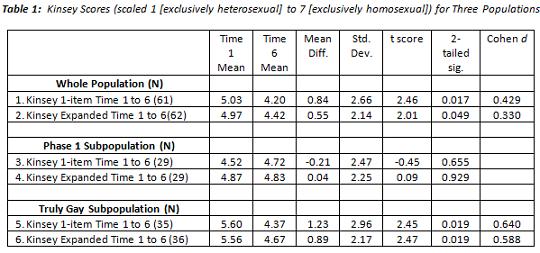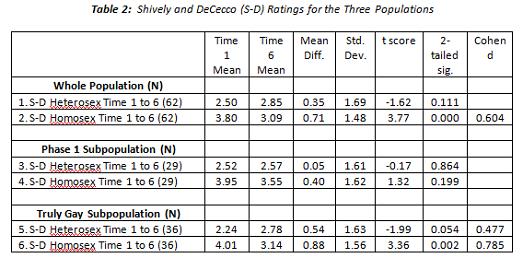Let me begin by saying that I endorsed the book, Ex-Gays, A Longitudinal Study of Religiously Mediated Change in Sexual Orientation, by Stanton Jones and Mark Yarhouse which contained the first report of their longitudinal study. Since the publication of the book, Jones and Yarhouse have released results of their final follow up, first in 2009 at the annual convention of the American Psychological Association, and then most recently in the Journal of Sex and Marital Therapy. With the follow up, I believe the study remains an important investigation into the interplay of religion, sexual orientation and personal identity. I give them credit for the perseverance required to explore a topic which is highly controversial and to report their findings in detail.
Since the release of the peer-reviewed article, socially conservative groups have described the study as proof that gays can change orientation. For instance, the American Family Association’s Bryan Fischer, one of the worst offenders, claims that the study proves gays can change and that they weren’t born gay. Also, Citizenlink, an affiliate of Focus on the Family reported:
Of the 98 subjects, more than half were reported as successful; 23 percent reported a complete change in orientation after six years. Also, 20 percent reported giving up the struggle to change.
This claim is misleading. Jones and Yarhouse did not report “complete change in orientation.” Instead they cautioned against misinterpreting their findings by saying
These results do not prove that categorical change in sexual orientation is possible for everyone or anyone, but rather that meaningful shifts along a continuum that constitute real changes appear possible for some. The results do not prove that no one is harmed by the attempt to change, but rather that the attempt does not appear to be harmful on average or inherently harmful. The authors urge caution in projecting success rates from these findings, as they are likely overly optimistic estimates of anticipated success. Further, it was clear that “conversion” to heterosexual adaptation was a complex phenomenon.
Regarding the changes reported by their participants, the authors offer two related explanations. One is that some of the participants changed sexual orientation to some degree and the other is that the participants changed their sexual identity. Sexual identity involves placing more emphasis on behavioral conformity to prohibitions on homosexual behavior as a means of self definition. For the Exodus participants, less temptation to engage in homosexual behavior might be taken as a signal that orientation has changed, thus allowing a different attribution about their sexuality than once believed. The authors raise these two possibilities in the abstract for the most recent paper:
The authors conducted a quasi-experimental longitudinal study spanning 6–7 years examining attempted religiously mediated sexual orientation change from homosexual orientation to heterosexual orientation. An initial sample was formed of 72 men and 26 women who were involved in a variety of Christian ministries, with measures of sexual attraction, infatuation and fantasy, and composite measures of sexual orientation and psychological distress, administered longitudinally. Evidence from the study suggested that change of homosexual orientation appears possible for some and that psychological distress did not increase on average as a result of the involvement in the change process. The authors explore methodological limitations circumscribing generalizability of the findings and alternative explanations of the findings, such as sexual identity change or adjustment.
As I read all of the literature, including my own work, I first want to disagree with the way that Citizenlink characterized the results as “complete change.” That is not at all what Jones and Yarhouse reported. Considering the dichotomy proposed by Jones and Yarhouse — change in orientation or identity – I lean toward their alternative explanation – “sexual identity change or adjustment.” However, I believe the discussion of what their results mean needs to be broadened beyond those two possibilities. In addition to considering orientation and identity as important constructs, I believe there are other ways to account for the changes Jones and Yarhouse report which are not sufficiently addressed in their published accounts. First, I want to make some observations about the study which influence my opinions about what the results mean.
First, and most basically, the Jones and Yarhouse study did not examine in any systematic way the efficacy of reparative therapy or any other kind of psychological therapy as a means of altering sexual orientation. The participants in the study were involved in religiously based support groups which primarily had as a goal to reinforce a traditional moral view of sexuality. Clearly, the participants hoped they would change and engaged in various religious interventions to assist that end. However, the study did not assess the role of professional therapy and cannot legitimately be used to say such therapies work.
Second, there were quite a few dropouts six to seven years into the study. While true of all longitudinal studies, the final percentages being reported should also take into account the distinct possibility that many if not most of the drop outs were not successful in their efforts to change. The study began with 98 participants and ended up with 65 who were followed up for six to seven years. Some reported that they were healed of homosexuality and just didn’t want to participate, while others said they were gay and stopped trying to change. I don’t know for sure what the dropouts mean but the fact that so many failed to complete the study needs to be a part of any discussion.
Third, ratings from men and women were combined. Given the low number of people involved I understand why this was done but the practice may inflate the assessments of change for the group. It has become well accepted that the sexuality of women is more fluid than for men. A few women experiencing large shifts could influence the group averages. Continue reading “The Jones and Yarhouse study: What does it mean?”


